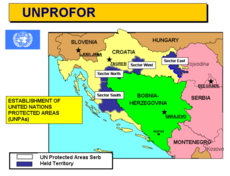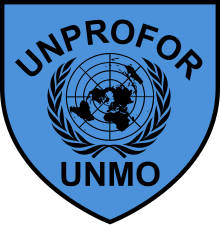United Nations Protection Force
| UNPROFOR | |
|---|---|
| operation area |
|
| German name | United Nations Protection Force |
| English name | United Nations Protection Force |
| French name |
Force de maintien de la paix de l'Organisation des Nations unies |
| Spanish name |
Fuerzas de Paz de la Organización de las Naciones Unidas |
| Based on UN resolution | 743 (February 21 1992) |
| Beginning | February 1992 |
| The End | December 20, 1995 |
| Operating strength (max.) | 32,480 military 684 military observers 803 civil police officers 2,017 international civilians 2,615 local residents |
| Deaths | 213 |
| costs | $ 1.6 billion (1994) |
| Location of the operational area |

|
The United Nations Protection Force (UNPROFOR), in German: Schutztruppe der United Nations , was the name of the international armed forces decided by the UN Security Council on February 21, 1992 in the areas of Bosnia and Herzegovina ( Bosnian War ) and Croatia ( Croatian War ). This was decided after, for the first time in the wars of Yugoslavia, a long-term ceasefire had been observed through the mediation of the UN negotiator Cyrus Vance .
The mandate was initially limited to twelve months, but was repeatedly extended until the Dayton Agreement was concluded in late autumn 1995. The following international troops in Bosnia and Herzegovina initially carried the name IFOR ( Implementation Force ) and since December 1996 the name SFOR ( Stabilization Force ). In December 2004, EUFOR ( European Union Force ) took over command of the international armed forces in Bosnia and Herzegovina.

The UNPROFOR mandate obligated the troops to be neutral and only allowed the monitoring of the observance of ceasefire agreements, which were repeatedly broken, and, to a limited extent, the protection and supply of the civilian population, especially in the UN protection zones established in 1993 .
States involved
Troops from Argentina , Belgium , Luxembourg , Denmark , Finland , France , Great Britain , Indonesia , Jordan , Canada , Kenya , Nepal , the Netherlands , Norway , the Czech Republic , Pakistan , Poland , Russia , Slovakia , Sweden , the took part in UNPROFOR Ukraine and the USA . Initially their total strength was 16,000 men and by November 1994 increased to 38,130 soldiers. The largest troop contingents were France with 4,493, Great Britain with 3,405, Jordan with 3,367 and Pakistan with 3,017 soldiers.
With the Bundeswehr , Germany was initially only involved in the context of logistical support and for air surveillance of the arms embargo over the Adriatic. Following a resolution of the Bundestag on June 30, 1995, a Franco-German field hospital was set up in Trogir (Croatia) to support UNPROFOR.
headquarters
- March 1992 to July 1992 in Sarajevo, meanwhile in Belgrade
- August 1992 to December 1995 in Zagreb
UNPROFOR commanders
- March 1992 to March 1993: Lieutenant General Satish Nambiar, India
- March 1993 to June 1993: Lieutenant General Lars-Eric Wahlgren, Sweden
- June 1993 to March 1994: General Jean Cot, France
- March 1994 to December 1995: General Bertrand de Sauville de La Presle, France
Srebrenica
There was strong international criticism after the Srebrenica massacre in July 1995. The United Nations had failed to protect the civilian population through the UNPROFOR mission. On July 11, 1995, Srebrenica was captured by Serbian troops under the command of General Ratko Mladić .
The UN protection forces offered no resistance. The occupation of the city was followed by one of the worst massacres of the Bosnian War, in which an estimated 8,000 Muslim Bosnians were murdered. This war crime has been carefully documented by the UN Special Rapporteur Tadeusz Mazowiecki .
In July he carried out extensive surveys among refugees from Srebrenica in the Tuzla region. This shows that on July 12th, Serbian units rounded up thousands of Muslims on a factory site in the suburb of Potočari - in the immediate vicinity of the UN quarter where Dutch blue helmets from the Dutchbat unit under Thomas Karremans were stationed. They selected women and children to be transported to Tuzla on buses and trucks. The men who stayed behind - including boys and old men - were led away.
Hakija Turajlić incident
The behavior of UN soldiers on January 8, 1993 was also criticized. On this day, Bosnian Serbs stopped the UN convoy with the Bosnian Vice Prime Minister Hakija Turajlić , who was on the way from Sarajevo airport to the seat of government, which was guarded by French soldiers . Shortly afterwards, Turajlić was shot dead in his car at a checkpoint.
Liberation of Bishop Perić
However, the protection force acted successfully on April 2, 1995, when they succeeded in freeing the Catholic bishop of Mostar-Duvno , Ratko Perić , from the hostage of Croatian irregulars in a chapel run by the Međugorj Franciscans without bloodshed . UNPROFOR was asked for help by the Mayor of Mostar .
Sarajevo
During the siege of Sarajevo , UNPROFOR's tasks included maintaining the airlift over the airport and supplying the population with relief supplies as well as other measures to protect the civilian population in the city. Armored vehicles aided pedestrians through dangerous sniper alleys. Furthermore, barricades were erected to protect against snipers by driving trams into position or by bringing containers, trucks or destroyed vehicles into position. UN vehicles were one of the few modes of transportation in the city. Furthermore, electrical lines were repaired and the garbage was removed.
See also
- NATO Operation Deny Flight
- NATO Operation Deliberate Force August – September 1995
Web links
Individual evidence
- ↑ Application by the Federal Government (PDF; 238 kB)
- ↑ German Bundestag plenary proceedings 13/48 of 30 June 1995
- ^ Military history. Journal for Historical Education, Issue 4/2005 (PDF; 3.2 MB)
- ↑ Article in Time magazine
- ↑ St. Gallen News
- ^ René Laurentin : Medjugorje Testament , Ave Maria Press, Toronto 1998, ISBN 0969738269 , quoted by Craig L. Heimbichner
- ↑ Michael Sells: Crosses of Blood ( Memento of July 8, 2012 in the web archive archive.today ), from Sociology of Religion ( Memento of May 8, 1999 in the Internet Archive ), Wake Forest University , Winston-Salem , Fall 2003
- ^ E. Michael Jones: The Ghosts of Surmanci , South Bend (Indiana) , February 1998
- ^ FAMA International - Sarajevo Survival Map 92-96



